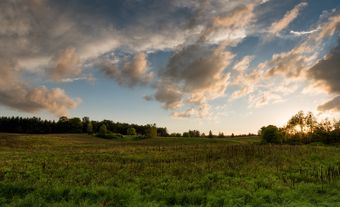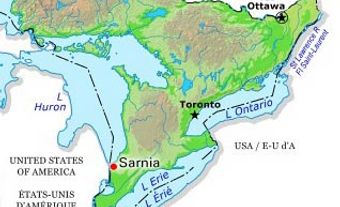Settlement
Prior to 1784, the Mississauga claimed the Grand River Valley among a large land area. The British government purchased this land and granted it to their Six Nations allies as recompense for their losses in the American Revolution.In 1798, the Government of Upper Canada, on behalf of the Six Nations, sold parts of this land in six separate blocks to land speculators in order to raise money to put towards an annuity for the Six Nation peoples. In 1803, Pennsylvania Mennonites purchased land, which became Waterloo Township in 1816, from Richard Beasley and established the nucleus of a large German-speaking settlement. The population increased due to the 19th century exodus from the continental German states of skilled craftsmen, artisans and tradesmen, as well as farmers and agricultural labourers. Both communities were incorporated as villages in the 1850s.
Development
Early development of the communities was determined primarily by the entrepreneurial skills and cohesive nature of the Germanic community. Economic growth was aided by Berlin's location on the Grand Trunk Railway. An effective system of municipal support, "bonusing" for industrial growth, led by prominent German-Canadian families aided Berlin's industrial pre-eminence in the area. In 1910, Berlin was the first inland city to have access to inexpensive power from Niagara Falls, which reinforced the industrial growth of the communities. Waterloo became a centre for the insurance industry and since 1911, of post-secondary education.
In 1916, during the First World War, Berlin changed its name to Kitchener when citizens, especially business owners, wanted to combat any perception of disloyalty due to its sizeable German-speaking population. In the Second World War, Kitchener was the site of a training camp for the Canadian Women’s Army Corps. During post-war reconstruction, the twin cities faced an acute housing shortage. The city of Kitchener converted Knollwood, the women’s army base, into temporary apartments, while in Waterloo the Veterans’ Green neighbourhood was built to house returning soldiers and their families. Direct access to Highway 401, the Macdonald-Cartier Freeway, in 1960 had a major impact, creating new industrial parks near the highway. A general recession hit Kitchener hard in the 1980s and since then, many of the companies that formed the backbone of the local economy have left or ceased operations. The location of two major universities in Waterloo (the University of Waterloo and Wilfrid Laurier University) and of Conestoga College in Kitchener, have attracted businesses interested in computer-related high technology, as well as a host of other highly skilled industries.
Cityscape
Pragmatism rather than aesthetics determined the location of both city cores, built on swampy terrain not suitable for agriculture. The Mennonite settlers surveyed the land that became Kitchener-Waterloo using a different method from the rest of Upper Canada and made no allotment for roads. The first urban settlements were located along the Great Road (later Highway 8) from Dundas. The initial survey, along with the subsequent establishment of industries along the route of the railway after 1856, created a discordant street pattern in Kitchener-Waterloo. The urban boundaries encroached only slowly on the existing farmlands, with no large annexations until the post-war population explosion in the 1950s.
In the 1890s the communities took advantage of new legislation to create large, centrally located parks, namely Waterloo Park (1890) and Kitchener's Victoria Park (1896). The Grand River, which runs along the eastern side of the cities, is designated a Canadian Heritage River.
Early housing, almost entirely of brick, was built in a local Germanic vernacular style. Since the early 20th century housing styles have conformed to national stereotypes: bungalows, ranch style, Gothic and Tudor, with recent attempts to recreate a Victorian ambience amidst ever-expanding new subdivisions. Strenuous efforts have been made to halt the erosion of the cities' central business core districts, with both communities having succeeded in urban renewal. The demolition of Kitchener's historic city hall (1974) led to a renewed interest in historic architecture and historic walking tours have become a popular pastime. The opening of Kitchener's award-winning "new" city hall in 1993 has successfully focused attention on its city centre, while in Waterloo the presence of the iconic Perimeter Institute and the Balsillie School of International Affairs have marked a strong architectural presence, so much so that on its central intersection Waterloo has three Governor General Award winning structures.
Population
The prevalent German language and culture of Kitchener and Waterloo at the turn of the century made the cities unique in Ontario. German immigration was insignificant following the 1870s, and by 1941 less than half the population self-defined as German. In the aftermath of the Second World War, Kitchener and its citizens led the nation in first welcoming new German refugees who fled or were expelled from eastern Europe (Romania, Yugoslavia, Poland and the Soviet Union). It has since retained its place as one of the centres in Canada most likely to receive refugees, aided by its vibrant local economy.
In addition to the large number of residents claiming German and Anglo-French origins, there are a prominent number of people of Polish, East Asian (particularly Chinese and Vietnamese), South Asian, Dutch, Italian and Ukrainian ancestry.
Economy and Labour
The original economic development of Kitchener and Waterloo was built around the business and artisanal skills of its German population. The communities became strongly identified with the automotive parts industry with companies supplying components to all of the major automobile manufacturing companies. Furniture and leather companies flourished in the early part of the century, but have since declined significantly, leaving only Krug Furniture with a national presence.
At the close of the 20th century, many long-standing industries ceased operations, including the Seagram distillery (1857) and Labatt's brewery (1870s). The footwear industry, once prominent in Kitchener, has also declined. Dare Foods continues to be important to the manufacturing base. Insurance companies have always played an important role in the economic life of the two cities and continue to do so with Sun Life Financial, Manulife Financial and Economical Insurance maintaining their presence in Waterloo.
The largest employer in Kitchener is Manulife Financial followed by Dare Foods. In Waterloo, BlackBerry followed by Manulife and Sun Life make up the city’s top employers. Waterloo also houses the Open Text Corporation, one of Canada’s largest software companies. The local economy, once centred around manufacturing, is now dominated by the service sector.
Communications
There are 13 radio stations in Kitchener-Waterloo: three are owned by Rogers Communications Inc; two by Bell Media; two by Corus Radio; two are university stations; one a college station; two are independently-owned; and one is the CBC. A television station, CKCO, was founded in 1954 and in 1963 was one of the stations that became part of a revised national CTV network; in 1996 CKCO entered into an agreement with Baton Broadcasting Inc, and is now known as CTV Kitchener. Kitchener-Waterloo is also served by a daily newspaper, The Waterloo Region Record which, in 1999, became part of the Torstar newspaper chain.
Government and Politics
Wellington District, of which Waterloo township was a member, was abolished in 1849 by the Baldwin Municipal Act. This legislation reorganized municipalities in the province by counties rather than districts. In 1852, the Hincks Act redrew boundaries laid out in 1849 and formed the United Counties of Wellington, Waterloo and Grey. This entity survived only until the three counties were prosperous enough to be administrated independently. In 1853, Waterloo became an independent county with Berlin as its seat. Its council first met on 24 January 1853 in Berlin’s newly constructed County Courthouse. The County Council levied taxes, created roads and bridges, administered justice and education. Representatives on County Council were drawn from the reeves and deputy reeves of the County municipalities. Berlin achieved city-status in 1912 and withdrew from the county; and Waterloo followed suit in 1948. The increasingly fragmentary and inefficient organization of municipal government in the area led to the creation of the Region of Waterloo on 1 January 1973. This Regional Council presided over planning issues and the provision of services, such as police, emergency services, waste management and social housing.
Both cities have independent municipal governments, headed by a mayor and councillors elected on a ward system. Until 1997 the chair of the Regional Municipality of Waterloo was elected by those local councillors who were elected first in their own municipalities, a percentage of whom also sat on the regional council. The chair is now elected in a region-wide election. In 2000, the number of regional councillors was reduced from 22 to 16 and, being elected directly, no longer hold office at the municipal level.
Cultural Life
Kitchener-Waterloo boasts of a vibrant and diverse cultural landscape that includes performing arts, sporting events, festivals, historic sites and art galleries. The Kitchener Memorial Auditorium or “The Aud” (1951) and Centre In The Square (1980), the community’s premiere entertainment venues, play host to locally as well as internationally-renowned musical and stage productions, including the Kitchener-Waterloo Symphony Orchestra and the Grand Philharmonic Choir. The Aud also regularly draws near capacity crowds for the Kitchener Rangers of the Ontario Hockey League (Junior A). The nine-day long annual Oktoberfest celebration is the largest event on the city’s cultural calendar. Residents and local businesses have added a uniquely Canadian flair to this traditional German festival with the addition of events such as a Thanksgiving Day Parade, which is broadcast nationally on CTV. Meat-packing company Schneider’s even created a special sausage for the event.
The Canadian Clay and Glass Gallery is of national significance and Woodside, the boyhood home of Prime Minister Mackenzie King, is a national historic site. Similar national historic site designation has been accorded to the Joseph Schneider Haus Museum, the Pioneer Memorial Tower and the home of Homer Watson, one of Canada's earliest landscape artists. Doon Heritage Crossroads, a re-creation of a 1914 rural village, and the award-winning Waterloo Region Museum, offer sophisticated historical interpretations of the former Waterloo County.

 Share on Facebook
Share on Facebook Share on X
Share on X Share by Email
Share by Email Share on Google Classroom
Share on Google Classroom




